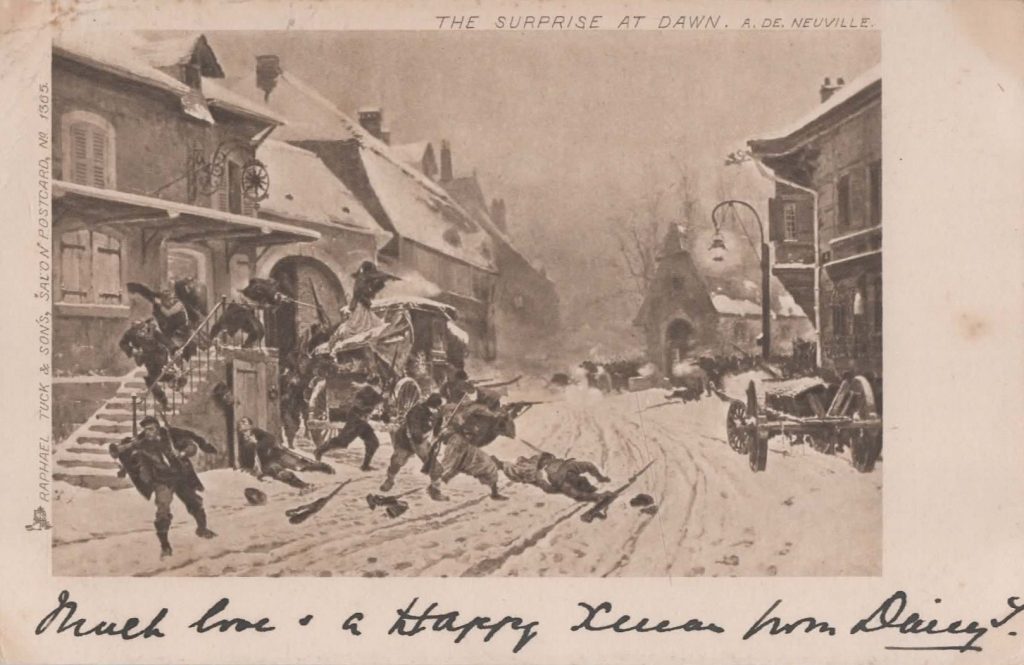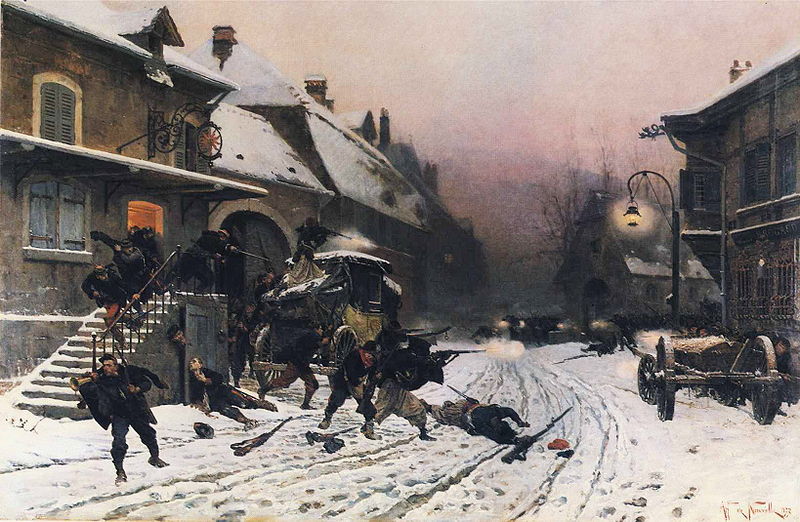It seldom makes a difference, but on this occasion, surely most people would agree that in a comparison of preferences, the color image is far superior to the monochrome example.
The postcard on the left, above, is from the Teevan Family collection. It was mailed with Christmas greetings from Daisy Teevan in Kensington to Miss Florence Constance Teevan in Faringdon, Buckinghamshire, on December 22, 1905. It may be that Daisy was a cousin of Florence Adelaide Teevan.
This undivided back card was published by Raphael Tuck & Sons. The copy seen here is sepia, but the same image was also published as a black and white card.
The artwork is that of Alphonse de Neuville and although the card is titled The Surprise at Dawn, the 1877 painting is variously referred to as The Attack at Dawn or the Surprise at Daybreak. The title variations are likely a consequence of varied translations of the French title.
Born Alphonse-Marie-Adolphe Deneuville to wealthy parents at Saint-Omer, Pas-de-Calais, de Neuville earned his degree of bachelier ès-lettres, and in 1856 entered the naval school at Lorient in spite of family opposition. It was there that his artistic instincts were developed.
The young Alphonse was discouraged by several painters of repute, but he was admitted and given permission to work in the studio of François-Edouard Picot. However, he did not stay. He was already painting by himself when he produced his first picture, The Fifth Battalion of Chasseurs at the Gervais Battery (Malakoff). In 1860, Neuville painted an Episode of the taking of Naples by Garibaldi for the Artists’ Club in the rue de Provence. In 1861, he sent The Guard Chasseurs in the Trenches of the Mamelon Vert to the Paris Salon.
The majority of de Neuville’s works are of a military nature and his dramatic and intensely patriotic subjects illustrate episodes from the Franco-Prussian War, the Crimean War, the Zulu War, and portraits of soldiers. He served as an officer in the Auxiliary Sappers and as aide-de-camp to General Callier during the Franco-Prussian War. He closely studied locations of battles and weaponry to recreate his battle scenes.
Neuville reached the peak of his career after the Franco-Prussian War of 1870–71. The long-term French reaction was revanchism: a deep sense of bitterness, hatred, and demand for revenge against Germany, especially because of the loss of Alsace and Lorraine. Paintings that emphasized the humiliation of the defeat were in high demand, such as The Spy by de Neuville in which he responded with a portrait attempting to glorify France’s heroic resistance rather than its military defeat. The consequence for de Neuville was that his fame spread rapidly.
Neuville was made an officer of the Légion d’honneur in 1881 and died in Paris on May 18, 1885.
The painting The Attack at Dawn is a recreation of a Prussian assault on a French village. At the left in the painting, a bugler sounds the alarm. French troops rush from the inn, their uniforms identify them as Turcos or Algerian rifleman and mobiles or members of the Garde Mobile. The mountain in the background, helps to identify the location of the scene as a village near the Jura Mountains, located near the Swiss border.
It is difficult to imagine why a prim lady like Daisy would select such a scene to pass along a Christmas greeting. Did she see the snow on the ground and think “that’s close enough?”
The companion card is a copy of The Attack at Dawn as it was painted, in color. It should be mentioned that in a search for this painting as a postcard several copies were discovered. Each quite different, with the color varying from that of a dark morning scene to one featuring a very blue sky.


Could the use of a battle scene as a Christmas greeting have been akin to the custom of sending “vinegar valentines”? Perhaps Daisy and Florence had had a falling-out shortly before this card was mailed.